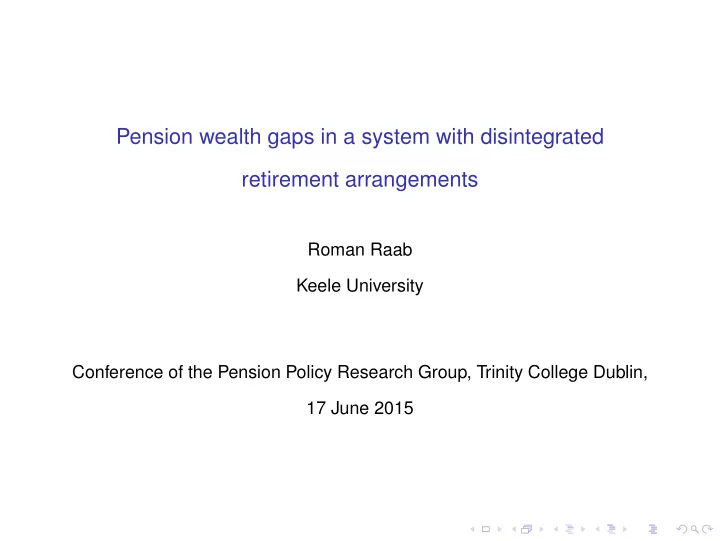

Pension wealth gaps in a system with disintegrated retirement arrangements Roman Raab Keele University Conference of the Pension Policy Research Group, Trinity College Dublin, 17 June 2015
Motivation ◮ Irish pension delivery follows philosophy of basic State Pension and privately organised complementary savings for retirement. ◮ Coverage with complementary pensions has been low. ◮ Concerns about inadequate retirement income and equality outcomes within current setup of pension delivery, e.g., Green paper on pensions (2007) and National pensions framework (2010). ◮ Study equality outcomes: looking at gaps across retirement income sources, over time, gender and position in pre-retirement earnings distribution.
Motivation, cont’d ◮ Adequacy of retirement income: ◮ Question: How much do people save for retirement? ◮ Optimal allocation of consumption and savings over life-cycle. ◮ Retirement-consumption-puzzle. ◮ Equality of retirement income: ◮ Question: How does one’s pension compare to others’ pensions? Similar standard of living in working life. ◮ Gap concept is pure outcome-equity measure.
Income sources in retirement ◮ State Pensions ◮ Flat rate benefit from age 65 ◮ About 230 Euros per week ◮ Occupational pensions ◮ Mandatory only for civil servants ◮ Most firm pensions are defined benefit schemes ◮ Benefits usually based on final salaries ◮ Social Welfare Programs ◮ Examples: Jobseeker’s Benefit, Jobseeker’s Allowance, Invalidity Pension ◮ May substitute lack of early retirement program ◮ Flat rate benefits close to State Pension level ◮ Private Pensions ◮ Relatively new option ◮ Coverage is currently only 13 percent of workforce
Coverage by retirement income source ◮ Two major coverage scenarios 1. State Pension and Social Welfare: 46 percent 2. State Pension and occupational pension: 37 percent ◮ Pension coverage of workforce in 2008 (in percent aged 20 to 69) SP SP + SP + SP + OP IP OP + IP Total workforce 46 37 13 4 Men 44 34 18 4 Women 49 40 7 4 Public administration 7 86 n/a 6 Hotels and restaurants 77 9 14 n/a Professionals 25 55 13 7 Sales 67 23 8 n/a Source: CSO (2008)
Pension wealth gaps ◮ Pension wealth - net present value of expected pension payments over retirement; variation by ◮ Retirement age ◮ Gender ◮ Pre-retirement earnings (except State Pension) ◮ Pension wealth gap - comparing pension wealth of agents from two different income sources; variation by ◮ Retirement age, gender, pre-retirement earnings ◮ Pension coverage
Simulations: Key parameters ◮ Simulation of gap-age-profiles ◮ Retirement window over ages 55 - 67 ◮ Representative agents at low/medium/high pre-retirement earnings ◮ Separate by males and females ◮ Three major country specific retirement income sources ◮ S1: Social Welfare and State Pension ◮ S2: Civil service occupational pension ◮ S3: Typical private sector occupational pension and State Pension ◮ Other parameters ◮ Retirement age for State Pension: minimum 65 ◮ Early retirement possible in occupational pension schemes ◮ Applying income and payroll tax rules of 2008 ◮ All numbers in real terms, and discounted to reference age 55 ◮ Simulations distinguish between 18 representative cases
Simulations: Gaps at average industrial wage Figure: Pension wealth and gaps, AIW
Simulations: Gaps at 50 and 150 percent of AIW 50 percent of AIW 150 percent of AIW
Conclusions ◮ Irish pension delivery generates significant inequalities in outcomes. ◮ S3-S1 gaps are highest relative to other gaps and increase in the age of retirement; maximum: over 250 percent difference in the high portion of the income distribution. ◮ Flat rate pensions organized by government, large inequalities may arise unless a second pillar of income in retirement is universally implemented. ◮ Pension reform initiatives since 2006 have addressed these equality issues; the remedy of automatic enrolment into a second pillar is correctly chosen. ◮ Second pillar retirement income managed by private companies is subject to financial market risk.
Recommend
More recommend